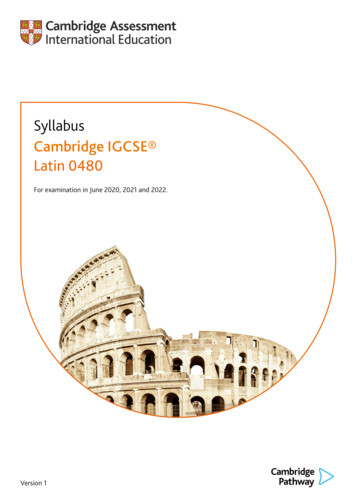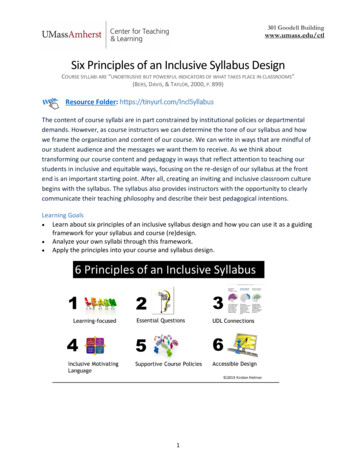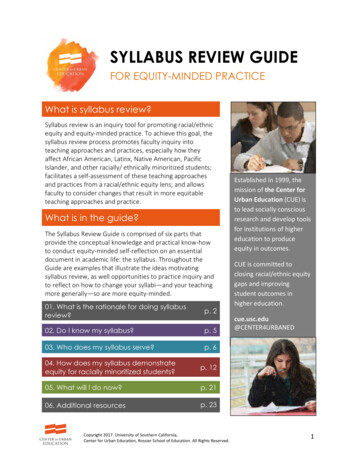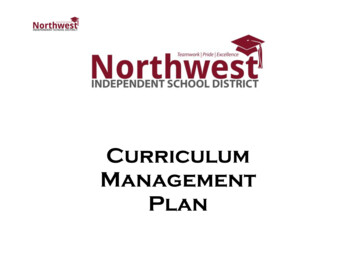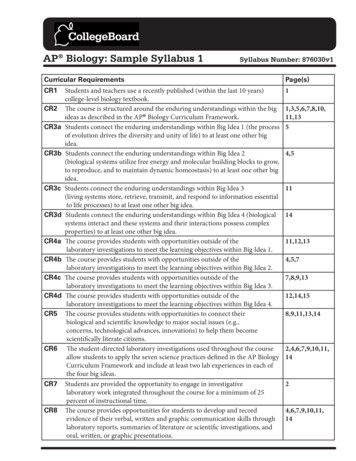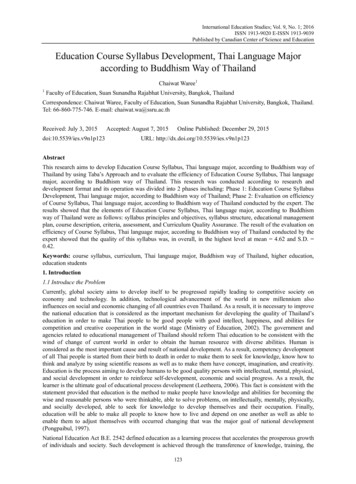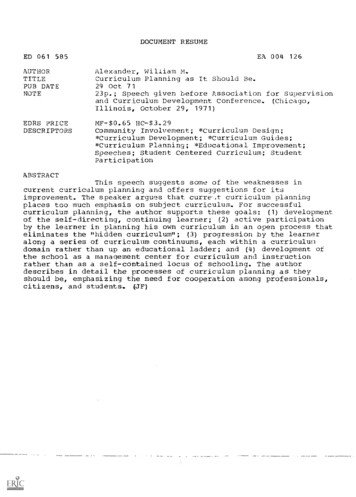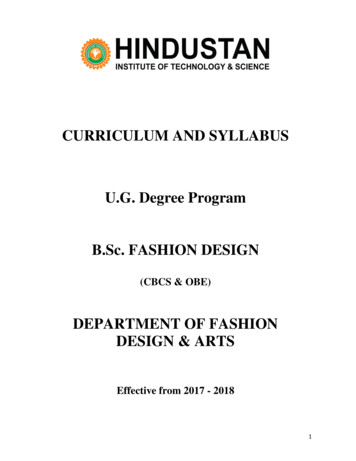
Transcription
CURRICULUM AND SYLLABUSU.G. Degree ProgramB.Sc. FASHION DESIGN(CBCS & OBE)DEPARTMENT OF FASHIONDESIGN & ARTSEffective from 2017 - 20181
VISION STATEMENT OF THE INSTITUTE“To Make Every Man a Success and No Man a Failure”MISSION STATEMENT OF THE INSTITUTETo provide every individual with a conducive environment suitable to achieve his/her careergoals, with a strong emphasis on personality development, and to offer the academicallyinclined the resources to gain quality education in all spheres of Engineering, Applied Sciencesand Management, without compromising on the quality and code of ethics2
DEPARTMENT OF FASHION DESIGN & ARTSVISIONTo sculpt young minds with design thinking, instill passion and flare for designing and helpaspiring students to become succesful designers, entrepreneures and industry readyprofessionals.MISSIONThe mission of Fashion, Design and Arts department is to provide education withinnovative curriculum, up-to-date technology, pedagogy, industry & foreign collaborations,while pioneering in experimenting and nurturing creativity by incorporating both classicand innovative design concepts.PROGRAMME EDUCATIONAL OBJECTIVES (PEO) :The Program Educational Objectives (PEOs) describe the professional accomplishments of ourgraduates about three-five years after having completed the under-graduate program in FashionDesign.PEO1Confident young Entrepreneur or Designer with his or her own designs orboutique or Garment unit.PEO2Garment Industry Professional who will excel in the job responsibilityentrusted on him or her.PEO3Confident and comprehensive academician having completed postgraduatedesign program inside India or abroad with strong portfolio.Freelance Consultant who helps the core and allied industry or individual ororganization in a specific design domain with their expertise.PEO4PEO5PEO6Educator or Trainer in fashion schools or organizations imparting and sharingthe knowledge acquired by them.Dynamic and confident individuals who excel in any profession they haveundertaken due to their strong foundation.3
PROGRAMME OUTCOMES (PO)Program Outcomes (POs), are attributes acquired by the student at the time of ion and Fabric Theory Knowledge: Understanding Theories &Principles of behind Fabric Constructions and its Science; History of Art,Textile, Costumes, Fashion theories, Styles, Marketing & Merchandising, ofthe past and present to appreciate trends, predict appropriate market trendsand machine knowledge.Design Process Knowledge: To apply the knowledge of elements of designand principles of design to create new design on paper, graphics, textile andgarments.Design / Develop product prototypes: Design a garment or a product bydraping or flat pattern making or by using hands on skill or stitching toconstruct the product to meet desired specification, performance andcapabilities: compatible with client need, trend, market analysis, social andenvironmental considerations.Modern Tool Usage: Computer Knowledge andskill to apply appropriateCAD and Computer Graphics knowledge to design and create new andindustry ready Surface or Garment or Style on computer.Value Addition: Applying traditional practices and methods to add value to aproduct or garment, creating a balance between the past practices andtechnological advancement.Visual Communication: To visually communicate ideas in the form ofartistic fashion illustrations, graphic illustration, styling, fashion photographyand visual display of merchandise.Event Management, Entrepreneurial and Business Skills: Demonstrateunderstanding to successfully conduct a fashion event or run an organization,handle its finance, HR and business .Designer and Society– Understanding and awareness on sustainable practicesfor the upliftment of the society and the environment and ethical behavior andIPR knowledge.Communication: Communicate and present effectively orally and in writing.Being able to comprehend and write effective reports and design documents,make presentations and give and receive clear instructions.Individual and team Work: Articulate teamwork principles, work withmultidisciplinary team, appreciate the role of a leader, leadership principlesand attitudes conductive to effective professional practices.Life Long Learning: Engage in life – long learning, demonstrate knowledgeand understanding of contemporary and emerging issues relevant to theirdomain – demonstrate knowledge and understanding of business practices andprinciples of management and understand their limitations, develop awarenessof legal consequences.4
Program Specific Outcomes The students will have strong foundation in designing and have the ability to visuallyrepresent it by illustrations, photographs, graphics and visual display of merchandise. The students will be able to convert their design into a product or a garment usingappropriate construction techniques. The students will be able to understand and analyze the market trends and design marketfriendly, sustainable, ethically viable and client friendly designs and products. Students will be able to work as a team in any organization and become accomplished orsuccessful Designers, Entrepreneurs or Industry ready professionals5
IMPORTANT ABBREVIATIONSAYAATCGPAAcademic YearAlternate Assessment ToolsCumulative Grade Point AverageCIEContinuous Internal EvaluationESEEnd Semester ExaminationCOCourse OutcomePCProfessional Core CourseACAllied CourseCPCore PracticalAPAllied PracticalBSBasic ScienceMPMini Project / InternshipDPDesign Project Collection / Major ProjectOEOpen ElectivePEProfessional ElectiveLTPSLecture-Tutorial/ Demonstration -Practical-Self-StudyCCCompulsory CorePEOProgram Educational ObjectivePOProgram OutcomeESESemester End ExaminationSGPASemester Grade Point Average6
SEMESTER – CREDIT TOTAL CGPA CREDITS130COURSE CATEGORY AND CREDIT DISTRIBUTIONSl.No.134.CodeSessionsper WeekMaxCreditsNo. ofCoursesTotalCreditsProfessional CoreCoursePC3T31339Allied CoursesAC2T248BS/FC2T144Open ElectiveOE3T122Professional ElectivePE3T326Core PracticalCP1T 4P31133Allied PracticalAP4P21428Minor ProjectMP-1/234DP-616Course CategoriesBasic Science/Foundation Course567798Design Project – FinalCollection7
NON CGPA COURSESGroupGroup AGroup B DescriptionCreditsAnyAdditional Internship2Online Certificate Courses - MOOC2Minimum one fromGroup AConference / Symposium- Paper presentation2Competitions related to Fashion2Certificate Courses2Workshops2Sports2NCC / NSS / Extra Curricular Activities2English Proficiency Certification2Co-Curricular Activities2Foreign Languages Course2Attending Conference / Seminar / Symposium2Minimum one fromGroup BThe Non- CGPA Course Credits must be earned by every studentcompulsorily for the requirement of the award of degree. Credits will not be calculated for CGPA, however the courses with grades canbe mentioned in the Grade Card. The Courses will not find any place in the regular time table. The GradesAssigned will be Satisfactory / Not Satisfactory - SA/ NS. Proof of completion must be submitted to the Class Teacher and HOD so thatthe same can be included in the Grade Sheet under Non-CGPA credits. Students with NS need not repeat the courses. Students can opt for any course under MOOC offered by NIFT / NID / IITDesign Depts., Coursera, EDX, NPTEL, MOOC from reputed FashionEducators or the MOOC courses suggested under each Course in the syllabus. The MOOC Courses should have assessment for grading the students. The Student must seek permission from Class Teacher and HOD beforeregistration Upon successful completion of the Course and submission of the certificatethe same can be included in the Grade sheet of the candidate under NonCGPA Credits.8
SEMESTER ICOURSECATEGORYCourseCodeNAME OF THE COURSELTPSCREDITSTCHTheory1PCFDB101Sewing Technology3001332PCFDB102Textile Science3001333PCFDB103History of WorldArt And 1ELA103Introduction 1Draping and BasicSewing Techniques0140537CPFDB132Elements of Design0140538APFDB133Visualization n I013142TOTAL 3121L – Lecture ; T – Tutorial / Demonstration ; P – Practical ; S – Self study9
SEMESTER IICOURSECATEGORYCOURSECODENAME OF THE COURSELTPSTCH CREDITSTheory1PCFDB105Fashion Studies3001332PCFDB106Fabric Study3001333PCFDB107World Textiles & Costume3000334BS/ FCFDA108Value Education200021Practical5CPFDB135Pattern Making I0140536CPFDB136Garment Construction I0140537APFDB137Computer Application II0131428APFDB138Fashion Illustration I0131429BS / FCFDA139English for FashionIndustry01102110MPFDB140Mini Project – Craft Study(Summer - 5 Days)-----13122TOTAL L – Lecture ; T – Tutorial / Demonstration ; P – Practical ; S – Self study10
SEMESTER IIISL.NOCOURSECATEGORYCOURSENAME OF THE COURSECODELTPSTCHCREDITSTheory1PCFDB201Textile Art300-332PCFDB202Traditional IndianTextiles andCostumes300-333PCFDB203Fashion ForecastingAnd Trend Study300-334OEFDF250OPEN ELECTIVE 1300-315CPFDB231Pattern Making II(Kid’s Wear)0140536CPFDB232GarmentConstruction II(Kid’s Wear)0140537APFDB233Design Process103-428APFDB234Fashion rfaceEmbellishment ITOTAL L – Lecture ; T – Tutorial / Demonstration ; P – Practical ; S – Self study11
SEMESTER IVSL.NOCOURSECOURSECATEGORY CODENAME OF THE COURSELTPSTCHCREDITSManufacturing Process300033Fashion Merchandisingand Retailing300033Business Management200022Open Elective Practical5CPFDB236Pattern Making III(Women’s Wear)0140536CPFDB237Garment ConstructionIII (Women’s Wear)0140537CPFDB238Advanced DrapingTechniques0140538APFDB239Digital PresentationTechniques0130429APFDB240Visual Merchandisingand Promotion10314210MPFDB241Textile Internship(Summer 10 Days)-----13423TOTAL L – Lecture ; T – Tutorial / Demonstration ; P – Practical ; S – Self study12
SEMESTER VSL.NOCOURSECOURSENAME OF THE COURSECATEGORY CODELTPSTCH CREDITS300033300033200022Professional 4PCACPEFDB301FDB302FDB303FDC370Costing And LeanManufacturingProcessIndustrial PatternMakingSustainability StudyPractical5CPFDB331Pattern Making IV(Men’s Wear)CPFDB332APFDB333GarmentConstruction IV(Men’s Wear)SurfaceEmbellishment IIAPFDB334Fashion arment Internship(Winter 20 Days)-----233256789AP10MPTOTAL L – Lecture ; T – Tutorial / Demonstration ; P – Practical ; S – Self study13
SEMESTER VISL.NOCOURSECOURSECATEGORYCODENAME OF THE COURSELTPSTCH 70Professional Elective II300033Practical3APFDB337Fashion Styling andPhotography0131424APFDB338Creative Pattern Making0131425DPFDB339Design Collection (MajorProject)001081062517TOTAL L – Lecture ; T – Tutorial / Demonstration ; P – Practical ; S – Self study14
SEMESTER ICOURSE TITLECourse CodeCIESEWING TECHNOLOGYFDB101Credits(100 Marks) 40%3L-T-P-SESE3-0-0-1(100 Marks) 60%15
Prerequisites : NilMODULE 1 – Sewing Machine & its Parts(10 L)Parts of a Sewing Machine and their Function. Threading a machine. Common problemsand methods to overcome.MODULE 2 – Industrial Sewing Machine(5L)Introduction to Industrial Sewing machine – Types - SNLS-DNLS-FOA-machine andmachine parts, bar tack machine - button-sewn machine, buttonhole machine terminology, safety rules, care and maintenance. Different types of sewing machine. Overlock Machine 3 & 5 thread –its application.MODULE 3 –Temporary & Permanent Stitches(10L)Sewing Treads and Selection of Sewing threads based on count. Temporary stitches:basting- even, uneven and diagonal. (ii) Permanent stitches: hemming, slip stitching,blanket, and fagoting. Making terminologies & symbols (notches, punch/circles,) Patterninformation (grain, part, piece, cut symbols) seam allowance, fabric terms (grain, Bowing).MODULE 4 – Seams & Seam Finishes(10L)Different types of seams- Plain seams, top stitched seam, welt seam, lapped seam, slotseam, flat fell seam, French seam, mantua maker‟s seam and piped seam. Seam finishesPiped finish, edge stitched finish, double stitched finish, overcast finish, herringbonefinished seam and bound seam edge finish.MODULE 5 – Fullness(10L)Fullness and its types - Darts, Tucks, Pleats, Gathers, Shirring, Ruffles and Godets.LAB / MINI PROJECT/FIELD WORKNATEXT BOOKS1.Cutting & Sewing Theory, Gayathri Verma & Kapil Dev, AsianPublishers, 20152.Garment Technology for Fashion Designers,Gerry Cooklin, Wiley-Blackwell,USA, 20123.Garment Manufacturing Technology, EIRI Board, Engineers India ResearchInstituteE BOOKSSewing Lessons For Beginners tsheets/FREE Sewing tlebooks.library.illinois.edu/brittlebooks .pdfFashion Studies –Text Book3.http://cbseacademic.in/web material/doc/fashion studies/3 XII Text Book.pdfMOOCTilly and the Buttons Learn to Sew- tml16
Learn to Sew - course.htmlSUGGESTED READSIndustrial Sewing MechanismStitching MechanismTime studyFundamentals of ApparelFitting, Marking, Stitching and FinishingASSIGNMENTS (Practical / Lab Component)Assignment 1 - Exercise on Machine Control & Speed, Paper Exercise & Fabric ExercisesAssignment 2 - Temporary & Permanent Stitches SamplesAssignment 3 - Seam, Seam Finishes SamplesCOURSE OUTCOMESPOPO1CO-1: Introducing about Sewing mechanism, Machineriesand material handling.CO-2: Understanding the features of sewing needles and fabricPO1handlingCO-3: Understanding the production quantity in each process andPO1stitching types.CO-4: Understanding the types of seamsPO3CO-5: Shaping the garment by using fullnessPO32ASSESSMENT CIE :SL.NO.1.23METHODOLOGYWritten testOnline QuizAssignmentsNO. OFASSESSMENTS213WEIGHTAGE40%20%40%Questions for CIE (40%) and ESE (60%) will be designed to evaluate the variouseducational components (Blooms taxonomy) such as:BT LEVELRemembering and understanding the course contentsApplying the knowledge acquired from the courseDesigning and analyzing problemsUnderstanding of various system modelsCOURSE TITLECourse CodeCIEWEIGHTAGE(weightage: 40%)(weightage: 35%)(weightage: 15%)(weightage: 10%)TEXTILE SCIENCEFDB102Credits(100 Marks) 40%3L-T-P-SESE3-0-0-1(100 Marks) 60%17
Prerequisites : NilMODULE 1 – TITLE: Introduction to Textiles(5L)Introduction to textile raw materials - Fiber, Filament, Yarn, Textile and Garment.End use of Textiles - Clothtech, Sporttech, Geotech, Oekotech, Packtech, Mobiltech,Indutech, Med Tech, Hometech, Buildtech, Medtech and Agrotech.MODULE 2 – Fibers(10L)Primary Properties of Fiber – Length to Width Ratio, Tenacity, Flexibility,Cohesiveness and UniformitySecondary properties of Fiber - Fiber morphology (Luster), Elongation and elasticrecovery, Resiliency, Moisture regain, Flammability and other thermal reactions,Electrical conductivity, Abrasion resistance, Chemical reactivity and resistance.Classification of Fibers based on origin – Natural & Manmade FibersNatural Fibers - Cellulosic (Cotton, Flax & Jute), Protein – (Wool and Specialty WoolenFibers), Silk and Mineral Fiber – Asbestos.Man Made Filament Fibers – Rayon, Polyester and Acetate FibersMODULE – 3 : Yarn(10L)Spinning –Spinning methods, Yarn Properties - yarn twist (S&Z directions), count andstrength.Mechanical Yarn Formation of Cotton, Jute, Linen, Woolen, Worsted & Silk Yarns.Chemical Spinning – Wet, Melt & Dry spinning of filament yarns.Yarn Types - Ply Yarn, Cable yarn, double yarn and novelty yarnsMODULE – 4 : Weaving(10L)Parts of a Basic Loom – Shuttle, Heddle, Reed, Warp beam & Cloth BeamBasic Weaving operation – Shedding, Picking, Beating, Taking in and Letting offTypes of Looms – Handloom, Power loom, rapier and Jacquard loomParts of a fabric – Warp, Weft, Grain, Bias and SelvedgeBasic Weaves – Plain Weave, Basket Weave, Rib, Twill, Satin and SateenComplex & Fancy weaves – Swivel, Lappet, Leno, Double Cloth, Pile and Jacquard.MODULE 5 - Knitting & Non-Woven Fabric Construction(10L)Differences Between Woven and Knitted Fabrics. Types of Knitting Machines; Circularand Flat Machines.General Knitting Terms- Wales, Courses, Face and Back, Knitting Needles, Cut andGauge. Knit Stitch, Purl Stitch, Miss Stitch and Tuck stitch. Fabrics : Single Jersey, DoubleJersey, Interlock, rib.Non-Woven Fabrics: Methods and Materials to Manufacture Non-Woven Fabrics;Bonded Fabrics; Foam Laminated Fabrics; FeltLAB / MINI PROJECT/FIELD WORKPractical testing of fibres /fabrics,Industrial visit to Textile & Fabric Manufacturing Unit and Textile Testing CenterTEXT BOOKS1. 1Garment Technology for Fashion Designers, Cooklins , Hayes, MsLoughlin &Fairclough, Wiley India, 201218
2. 23. 3Fibre to Fabric, Bernard P Corbman, Tata McGraw - Hill Education, 2003Textile Science: An Explanation of Fibre Properties, Gohl & Vilensky , CBSPublishers, 20054. 4Textiles, Sara J. Kadolph, Pearson publication, 2009E BOOKS1Hand Book of Technical 10/handbook of technical textile .pdf2Textiles & Clothing - i-voctextiles-em.pdf3Fabric Study - http://cbse.nic.in/publications/vocational/Fashion udy%20%20(Textbook%20 %20Practical%20Manual)%20XII.pdf4Fiber to Fabric - ED READSDifferent types of Natural and Synthetic Fibres : Kapok, Pina, Coir, Spider silk, Nylon,Polyurethane, Specialty Woven and Knitted Fabrics, Technical le-fundamentals-mooc-marist-collegeASSIGNMENTS (Practical / Lab Component)Collection of different fibre samples & observation under microscopeCollection and analysis of woven, knitted and non-woven fabric swatchesReport on the Industrial Visit to a Textile Testing LabCOURSE OUTCOMESPOPO1CO1 - To obtain basic knowledge on Textile IndustryPO1CO2 - To be familiar with the terminology used in textilesPO1CO3 - To understand the performance characteristics of fibre, yarn and fabricsPO1CO4 - To understand the process flow of Textiles from Yarn to FabricPO1CO5 - To obtain knowledge on various fabric formation processesCIE: ASSESSMENTSL. NO.METHODOLOGYNO. OF ASSESSMENTSWEIGHTAGE1.Written test240%2.Online test - Quiz120%3.Assignments340%Questions for CIE (40%) and ESE (60%) will be designed to evaluate the variouseducational components (Blooms taxonomy) such as:BT LEVELWEIGHTAGERemembering and understanding the course contents(weightage: 40%)Applying the knowledge acquired from the course(weightage: 35%)Designing and analyzing various problems(weightage: 15%)Understanding of various system models(weightage: 10%)COURSE TITLECourse CodeCIEHISTORY OF WORLD ART AND CULTUREFDB103Credits(100 Marks) 40%3L-T-P-SESE3:0:0:0(100 Marks) 60%19
Prerequisites : NilMODULE 1 - Introduction to World Art & Cultures(5L)Introduction:Basics of „Visual perception‟ and „Visual Communication‟- Ancient Civilizations &Materials used. Development of Visual Forms during Prehistoric, Egyptian & Mesopotamiancivilization.MODULE 2 - Ancient Art & Architecture(10L)Romanesque and Gothic architecture - Gothic and early Renaissance painting - Development ofarches, vaults, buttresses and stained glass windows.Painters having individuality in terms of style- Giotto, Duccio & ComabueMODULE – 3 : Visual Art(10L)Rajput and Mughal Miniature paintings/ architecture. Temple Architecture in South India,Ajantapainting, Ellora sculptures. Famous Indian Art and Artist.MODULE – 4 : Classical Art Periods and Artist(10L)Baroque, Rococo, Neoclassicism, Romanticism, Realism, Impressionism, Fauvism, cubism,futurism&Naturalism – Monet, Manet, Van Gogh, Edvard Munch, Henri Matisse, Kandinsky &August RodinMODULE 5 – Avant Grade & Post Modern Visual Art(10L)Dada, Abstract- Expressionism, surrealism, Pop Art, Op Art, Minimalism, Photorealism, NeoExpressionism, Digital Art, Street ArtArtist - Marcel Duchamp, Pablo Picasso, Jackson Pollok & Kasimir MalevichLAB / MINI PROJECT/FIELD WORK Field Trips -Art Exhibition & Chennai Egmore MuseumTEXT BOOKS1. Art: A World History, Elke Linda Buchholz (Author), SusanneKaeppele (Author),Karoline Hille (Author), Irina Stotland (Author), GerhardBuhler(Author), Harry N. Abrams (November 2007)2. The Complete Visual Guide Artists in History - Painting, Sculpture, Styles andSchools (Big Ideas), Robert Cumming, Penguin (September 2015)3. Indian Art and Culture Paperback – 11 Jan 2015 by Nitin Singhania4.The Short Story of Art, Susie Hodge, Lawrence King Pub, 2017E BOOKS1Indian Culture and CHCour/English/CH.02.pdf2The Story of Textiles - /wp 19251.pdf3Fashion Studies –Text Bookhttp://cbseacademic.in/web material/doc/fashion studies/3 XII Text Book.pdfSUGGESTED READSStudy about different artistsStudy about different types of world artMOOC20
wmaASSIGNMENTSPresentation on comparison of east and west culture and artDeveloping a product inspired from any form/period of world artCOURSE OUTCOMESCO1 - To obtain basic knowledge on world artCO2 - To understand the techniques used for different world artCO3 - To obtain basic knowledge and understand the techniques ofpaintings/ architecture of IndiaCO4 - To obtain basic knowledge and understand the differenttechniques of Modern Art Movements, Avant Grade & Post ModernVisual ArtCO5 – Utilizing the knowledge gained on art and Culture to makeminiature prototype / model.ASSESSMENT CIE :SL.METHODOLOGYNO.1.Written test2.Quiz3.Assignments4.Mini project5.SeminarNO. 20%20%10%Questions for CIE (50%) and ESE (50%) will be designed to evaluate the variouseducational components (Blooms taxonomy) such as:BT LEVELRemembering and understanding the course contentsApplying the knowledge acquired from the courseDesigning and analyzing various problemsUnderstanding of various system modelsCOURSE TITLEWEIGHTAGE(weightage: 40%)(weightage: 35%)(weightage: 15%)(weightage: 10%)ENVIRONMENTAL SCIENCECourse CodeFDA104CreditsCIE(100 Marks) 40%Prerequisites : Nil2L-T-P-SESE2:0:0:0(100 Marks) 60%21
MODULE 1 : Natural Resources : (5L)Definition, scope and importance, of environmental studies,Need for public awareness.Renewable and non-renewable resources :Natural resources and associated problems.a)Forest resources : Use and over-exploitation, deforestation, case studies. Timberextraction, mining, dams and their effects on forest and tribalpeople.b) Water resources : Use and over-utilization of surface and ground water, floods,drought, conflicts over water, dams-benefits andproblems.c) Mineral resources : Use and exploitation, environmental effects of extracting andusing mineral resources, casestudies.d) Food resources : World food problems, changes caused by agriculture andovergrazing, effects of modern agriculture, fertilizer-pesticide problems, waterlogging, salinity, casestudies.e) Energy resources : Growing energy needs, renewable and non renewable energysources, use of alternate energy sources. Casestudies.f) Land resources : Land as a resource, land degradation, man inducedlandslides, soil erosion anddesertification. Role of an individual in conservation of naturalresources.Equitable use of resources forsustainable lifestyles.MODULE – 2 : Ecosystems (5L)Structure and function of anecosystem, Concept of anecosystem, Producers, consumersanddecomposers, Energy flow in theecosystem, Ecologicalsuccession, Food chains, foodwebs and ecologicalpyramids, Introduction, types, characteristic features, structure andfunction of the following ecosystem:- Forest ecosystem, Grassland ecosystem, Desertecosystem, Aquatic ecosystems (ponds, streams, lakes, rivers, oceans,estuaries)MODULE – 3 : Biodiversity and its conservation(3L)Introduction – Definition : genetic, species and ecosystemdiversity. Bio-geographicalclassification ofIndia, Value of biodiversity : consumptive use, productive use, social,ethical, aesthetic and option values, Biodiversity at global, National and local levels. Indiaas a mega-diversitynation, Hot-sports of biodiversity. Threats to biodiversity : habitatloss, poaching of wildlife, man-wildlifeconflicts. Endangered and endemic speciesofIndia. Conservation of biodiversity : In-situ and Ex-situ conservation ofbiodiversity.MODULE 4: Environmental Pollution (4L)Definition, Cause, effects and control measures of:- Air pollution, Waterpollution, Soilpollution, Marine pollution, Noise pollution, Thermalpollution, Nuclear hazards, Solidwaste Management : Causes, effects and control measures of urban and industrialwastes.Role of an individual in prevention ofpollution. Pollution case studies. Diastermanagement : floods, earthquake, cyclone andlandslides.MODULE 5 : Social Issues and the Environment (4L)From Unsustainable to Sustainabledevelopment, Urban problems related toenergy, Waterconservation, rain water harvesting, watershedmanagement, Resettlement andrehabilitation of people; its problems and concerns. Case Studies, Environmental ethics :Issues and possiblesolutions. Climate change, global warming, acid rain, ozone layerdepletion, nuclear accidents and holocaust. CaseStudies. Wastelandreclamation.Consumerism and wasteproducts. Environment ProtectionAct. Air (Prevention andControl of Pollution) Act. Water (Prevention and control of Pollution)Act, WildlifeProtectionAct, Forest Conservation Act, Issues involved in enforcement ofenvironmentallegislation. Public awareness.22
MODULE 6 : Human Population and the Environment (4L)Population growth, variation amongnations. Population explosion – FamilyWelfareProgramme. Environment and humanhealth. HumanRights. Value Education.HIV/AIDS. Women and ChildWelfare. Role of Information Technology in Environmentand humanhealth. Case Studies.TEXT BOOKS1Cunningham, W.P. Cooper T.H. Gorhani, E & Hepworth, M.T. 2001,Environmental Encyclopedia, Jaico Publ. House, Mumabai, 1196p2Text Book for environmental Studies For UGC, Erach Bharucha, 2004E BOOKS1 fSUGGESTED READSCase Studies on Environmental l-studies/ASSIGNMENTSPoster on Environment awarenessRecycled productCOURSE OUTCOMESPOCO1 - To understand our natural resources and the environmentPO8CO2 - To understand the importance of EcosystemPO8CO3 - To understand the biodiversity of the planetPO8CO4 - To obtain basic knowledge on environment pollutions and its typesPO8CO5 – Understanding the Social Issues and the impact of Population on the PO38 &EnvironmentPO11ASSESSMENT CIE :SL.METHODOLOGYNO. OFWEIGHTAGENO.ASSESSMENTS1.Written test240%2.Quiz120%3.Seminar120%4.Mini project120%Questions for CIE (40%) and ESE (60%) will be designed to evaluate the variouseducational components (Blooms taxonomy) such as:BT LEVELWEIGHTAGERemembering and understanding the course contents(weightage: 40%)Applying the knowledge acquired from the course(weightage: 35%)Designing and analyzing various problems(weightage: 15%)Understanding of various system models(weightage: 10%)COURSE TITLEIntroduction to Communication SkillsCourse CodeELA103CreditsCIE(100 Marks) 40%Prerequisites : Nil1L-T-P-SESE2:0:0:0(100 Marks) 60%23
MODULE 1 – LISTENING SKILL(5L)Listening to short and extended dialogues, telephone conversations, discussionListening to prose & poetry reading Listening to video clips, documentaries, feature films,presentations, interviews -- Listening for the gist of the text, for identifying a topic, generalmeaning and specific information -- Listening for multiple-choice questions, for positive &negative comments, for interpretationMODULE 2 – SPEAKING SKILL(5 L)Introducing oneself or expressing personal opinion -- Simple oral or casual interaction –Dialogue -- Conversation – Participating in group discussions, role plays and interviews,Addressing a small group or a large formal gathering. Debates, discussions and role plays onadvanced topics, Brief Power point presentationMODULE – 3 : READING SKILL(5 L)Basic Reading Comprehension and interpretation, Reading for the gist of a text, forinformation transfer and interpretation. Reading for specific information, instructions,recommendations, functional checklists, Reading comprehension exercises for multiplechoice questions, for contextual meaning -- Reading newspapers, magazine articles oftopical interest and eventsMODULE – 4 : WRITING SKILL(5 L)Writing emails, messages, notices, agendas, leaflets, brochures, minutes of a meetingWriting formal business and official Letters inviting, accepting, declining the invitation,Requesting permission for industrial visits or implant training, Letter applying for a job,enclosing a CV. Writing short repots -- Writing short proposals.MODULE 5 - OVERALL COMMUNICATION SKILL(5 L)Development of oratory skills through practice of speaking on various topics. HoneConversation skills by engaging in discussion on topical issues. Inculcate habit ofexploring various events and interesting news and sharing it with others.LAB / MINI PROJECT/FIELD WORKNilTEXT BOOKS1. Oxford Guide to Effective Writing & Speaking skills, John Seely, OxfordPublishing, 2013Wren & Martin, High School English Grammar and Composition, D.V. Prasada2.Rao N, N.D.V. Prasada Rao, 2017E BOOKSEnglish Language – TN College Text Book dted1-english.pdfSUGGESTED READSDaily NewspaperE iness-english-basics-courseraA
Textile, Costumes, Fashion theories, Styles, Marketing & Merchandising, of the past and present to appreciate trends, predict appropriate market trends and machine knowledge. PO2 Design Process Knowledge: To apply the knowledge of elements of design and principles of design to create new design on paper, graphics, textile and garments.



